|
Other lives brought home Playwright Satinder Kaur Chohan journeys to the Punjab to research Zameen, her play about land and families caught in the global economies of cotton, seeds and debt.
In May 2007, I travelled to north-west India to research my play Zameen (Land). Set in the cotton fields of Punjab, Zameen seeks to weave a 21st century topical tale of globalisation around the village lives of a small, cotton-farming family.
My own family had been farmers in Punjab. My father migrated to Britain in 1968 and my mother followed five years later, with my brother and sister, before I became the only British-born member of the immediate family. I grew up in Southall, West London – a town familiarly known as ‘Chhota Punjab’ (‘Little Punjab’). In Southall, Punjab rarely feels thousands of miles away.
Punjab has always been known for its fertile plains and boasts a rich cultural and spiritual history. It’s the birthplace of one of the world’s oldest civilisations, the Indus Valley Civilisation, and Sikhism, Hinduism, Buddhism and Sufism have all flourished there. Invasions and conquests by Aryans, Persians and Greeks among others, have bred a proud and resilient people. As a young girl in West London, I used to listen avidly as my father told me stories about the warriors and saints of Punjab and also, about the robust Punjabi farmers, borne of the soil and connected to nature.
I had visited Punjab once when I was seven, before returning in 2004. At that time, I was working as a researcher for the BBC series ‘Who Do You Think You Are?’, researching the ancestry of Meera Syal, the star of ‘The Kumars At Number 42’. Syal was born in Wolverhampton but her parents were born in Punjab. While I was there, I read an article about an ‘economics of genocide’ that was driving thousands of farmers to suicide across India, from Maharashtra, Andhra Pradesh to Madhya Pradesh, Karnataka and Punjab. According to official figures, over 150,000 farmers took their own lives between 1997 and 2007. They continue to do so.
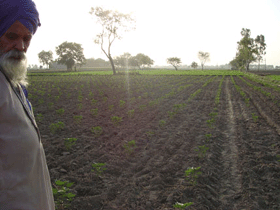
Punjabi farmer
|
Back in the UK, I saw a request for short plays by Kali Theatre, a theatre company in London specializing in writing by Asian women. Almost instantly, I knew I wanted to write a play set in the land of my ancestors, one in which the forces of fate and destiny that used to shape village lives are superseded by the rich and powerful gods of economic globalisation. It would be a modern Indian tragedy that captured the convulsive passing of an old India and the dawning of a new globalised one.
After reading more widely about farmer suicides and the impending environmental crisis in Punjab, I began trying to express these global issues through the microcosm of a small, dysfunctional family. My core characters slowly emerged - Baba, the ageing and hard-working cotton farmer, struggling against the vagaries of nature and the modern world; Chandni, the dutiful daughter, who dreams of escaping her prescribed womanly fate; and Dhani, the alcoholic and drug-addicted son, who dreams of escape to ‘Amrika’.
The play went through a series of stages. An initial twenty-minute piece was selected by Kali for the Kali Futures Development Programme. After workshops with other new writers, a slightly re-written Zameen was presented as a rehearsed reading at Watermans in July 2005. The play was then selected by Kali for a one-hour rehearsed reading at the Soho Theatre in November 2005. As I developed the play, I added two characters, both of whom embodied a global dimension – Lal, a village moneylender who doubles up as a local commission agent (seller of corporate seeds and pesticides); and Suraj, his son and Chandni’s childhood sweetheart, who returns from a brief period away as an illegal immigrant in ‘Amrika’.
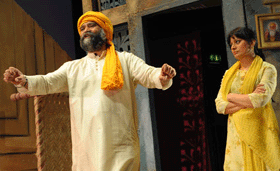
Zameen: Baba and Chandhi
|
In autumn 2006, I began developing Zameen into a full-length piece, fleshing out the plot and characters, with advice from Kali director Paulette Randall and dramaturg Penny Gold. In November 2006, the ninety-minute version of Zameen was presented as a studio production as part of Kali Theatre’s Asian Women’s Talkback Festival at Soho Theatre.
For many months, I had sat at my desk in Southall writing ‘Zameen’ using only newspaper reports, books (such as Indebtedness, Impoverishment and Suicides in Rural Punjab by K. Gopal Iyer and Mehar Singh Manick) and my parents’ shaky memories of agricultural life in Punjab. Yet after the workshop production, the research still seemed inadequate and the creative process incomplete. So in spring 2007, I applied for Arts Council funding to help me research and develop the piece more thoroughly in Punjab, to understand first-hand the issues, the land and the people I had read about in reports and written about in the play.
In May 2007, I arrived in Barnala, Punjab, at the beginning of the cotton-sowing season. I travelled across the cotton belt, visiting villages in the southern districts of Sangrur, Moga and Bathinda. Stepping into these villages is akin to taking a step back in time – to the Punjab I visited as a child – or perhaps even the Punjab my parents fondly remember. Ostensibly, this is the old Punjab of close-knit families and village communities, wholesome food from the fields cooked over a chula stove, sleeping out on a charpoy under the stars, drinking endless cups of chai, gossip, laughter...
Before leaving for Punjab, I had contacted the Movement Against State Repression in Chandigarh, a non-profit organisation partly involved in gathering information about farmer suicides in Sangrur and providing support to the families of suicide farmers through the Rescue and Revival Mission arm of the Baba Nanak Educational Society. In Bathinda, I contacted the Punjabi Bharat Kisan Union (Punjabi Farmer’s Union). I also contacted Umendra Dutt, Executive Director of the ecological NGO Kheti Virasat Mission, which tirelessly promotes sustainable agriculture and natural farming throughout Punjab.
These vital contacts gave me invaluable advice, informed perspectives and trusted contacts within the villages themselves. I stayed with cotton-farming families, immersed myself in the rhythms and routines of village life and interviewed cotton farmers, suicide widows, young village men and women - even moneylenders. It was a heart-rending but also creatively affirming journey in which the characters I had imagined, sitting at my desk in Southall, seemed to come alive in the real-life setting of Punjab.
Baba
I first glimpsed Baba, the ageing farmer, on his land in Sangrur. One of the farmers had taken me out to his cotton fields to explain the seasonal process of sowing, growing and plucking cotton. On the edge of a field, sprouting with cotton seedlings, there was a lone Neem tree, as there is in the play – and just for a moment, I felt as though I was standing in Baba’s fields...
The struggles of the land are etched on the timeworn faces of the farmers, who work unceasingly from sunrise to sunset. Here, the older farmers talk about a farming past and its more arduous present.

Punjabi parents
|
Reminding me of Baba, Maghar Singh, whose son committed suicide at the age of 35, told me, “We used to sow a lot of things – cotton, vegetables, lentils, chickpeas. Now, there are only two things left – cotton and rice. All you needed was an iron plough. We used to have everything here. We grew our own crops, made our own milk, butter and sugar, we saved seeds, used medicines like turmeric and mustard oil, spun our own cotton, made our own clothes, coloured them with dye, used a desi soap made of plants and washed our clothes with it. Now, people are embarrassed to wear homemade cotton and go out and buy their clothes. Machines took over in the houses and the fields. The Green Revolution changed everything.”
Dhani
I glimpsed Baba’s wayward son Dhani when I saw him falling like a leaden weight, by the side of the charpoy, after he didn’t quite steady himself enough to sit on it. I saw him again on another charpoy, weeping out of desperation to leave the village for abroad.
As excessive chemical use contaminates the Punjabi land, drugs and alcohol grip the village boys, who see only back-breaking work and scant profit in agriculture. I visited a small De-Addiction clinic in Bathinda, a heaving bus ride from the cluster of rural villages where I was staying. In 2002, 67 people admitted themselves. In 2006, numbers were over 700. There is a surprising mixture of both old and young, labourers, farmers and students.
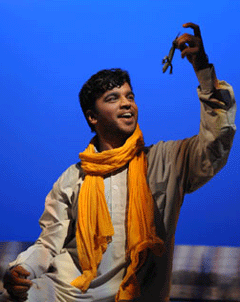
Zameen: Dhani
|
The only women are the wives and mothers of patients. Women are not immune to addiction but, even here, it would be taboo for them to admit themselves to the clinic as addicts. The men talk about addictions to alcohol, opium, smack, cough syrup, correction fluid, ganja, bhukki and pharmaceuticals. Bhukki, an opiate, is popular among older farmers, who believe that the drug increases work productivity. Younger men deploy new methods of addiction - spreading boot polish on chappatis or smoking gecko tails.
One 22-year old village boy said, “The boys don’t know what they’re taking or not taking. They can’t get up in the morning and can’t go to sleep at night without drugs. They say, if we don’t take drugs, we have to live in pain all day.”
For most village boys, there is chemical escape and/or dreams of migration. When I told the villagers that I was Punjabi but born and brought up in Britain, they excitedly introduced me to others: "She’s from Amrika!" The air crackled with light-hearted marriage proposals on behalf of absent sons and nephews and talk of legal and illegal routes abroad.
It has taken almost four decades since my father left Punjab for migration to reach the remote southern parts of Punjab but now, the villagers talk excitedly about the one or two men lucky enough to pursue riches elsewhere. They hope their own sons will be next but know that the price tag of tens of thousands rupees may not be raised and (re)paid in their lifetime.
Chandni
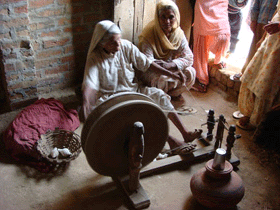
Punjabi women and spinning wheel
|
I glimpsed Baba’s dutiful daughter, Chandni, undertaking her daily domestic chores. First, I saw her in Sangrur, head-covered, filling a pail of water from the water pump, stirring lady-fingers over the chula stove, carrying in a tray of quaint little cups of tea for the newly arrived guests. In Bathinda, I saw her, head uncovered, interrupting her daily chores to watch the Indian morning TV serials with female friends.
In a state that boasts a strong matriarchal tradition, Punjab has the worst child sex ratio in India due to its high rate of female foeticide (according to the United Nations Population Fund, there were 798 girls to every 1000 boys in 2001). Villagers did not speak openly about the overwhelming pressures of producing a son but there were murmurings about other women having had illegal pre-sex determination scans to reveal whether the child would be male or female, and then, keeping or getting rid of the baby accordingly. One woman told me of a doctor who was participating in a public education campaign against female foeticide but conducting illegal abortions for a fee.
For village girls, lives have been mapped out in the form of dowries, marriage and producing male heirs. Casting aside equalising state and national inheritance laws, girls rarely see an equal share of their parent’s property or land. Instead, they receive a dowry upon marriage, determined by the boy’s family.
A suicide widow Taran Kaur, 25, told me, “When I got married at fifteen, I didn’t have a dowry. Nowadays, the girl’s family have to buy televisions, coolers, washing machines, motorcycles, cars, even hand over cash or land, depending on what the boy’s family demands.” As India embraces Western-style consumerism, even village dowries must include expensive, modern household products, leading some villagers to think it easier to do away with a daughter’s later financial burden prior to birth.
First transcription

Punjabi women picking cotton
|
In late June 2007, I returned to the UK with hundreds of photographs and sixty taped interviews, which I began to transcribe with the help of my father and sister-in-law. Sometimes, they were in tears. Other times, they wondered if it was necessary to be so meticulous. I felt like I needed to work carefully through all the interviews as I might find a word, anecdote, emotion or feeling that would tell the story better or infuse more power into the play. I tried to listen to the Punjabi closely, translating words or phrases that sang with images or metaphors.
Rural Punjabi certainly retains a colour and vibrancy that a colloquial ‘British-Punjabi’ is rapidly losing. Zameen is conceived in Punjabi but it is written like a play in English translation. Treating it as such, the actors would later perform the play in their own British accents. As I continued to transcribe the interviews through the summer, I began to wonder more and more how Baba, Chandni and Dhani might be readying themselves for the impending harvest. So, after delving into some savings, I returned to the family with whom I stayed in Bathinda to see the cotton in bloom, and bring the cotton cycle to a close. The second journey
If the first trip to Punjab had been very work-structured, the second was a little more meandering – soaking up the joy, pain and nuances of village life.
In the village of Bhuccho Khurd, I jumped into the farmer’s tractor trolley to join the other women pickers, thinking a lot about Baba and Chandni. We joined the small convoy of other tractors, trundling down the long, dusty, road into the cotton fields.
From afar, the cotton looked like a light dusting of snow. Close up, a jungle of spiky cotton sticks scratched as we plucked cotton balls from the pods. Many stalks were covered in mealy bug – the latest pest of many to ravage Bt cotton in the fields. There were tobacco caterpillars and other pests, crawling over the plants and sometimes, my clothes.
I could not pick as quickly as the others, nor lasted as long, often sneaking away to stretch out under the kikar tree or lie on a charpoy when the heat or work became too much. The women had no such choice – they worked from morning to sundown, cotton sacks swelling on their backs, laughing and gossiping to get through the sweltering day. We shared water and tea, made on a fire sparked out in the open and ate roti with chutney for lunch. At the end of the day, the cotton pickers weighed their produce on huge scales in the fields and were paid according to weight. After that, we trundled back on the tractor through the fields, a blazing red bindi sunset high in the sky.
Back in the UK, after transcribing all the interviews, I sifted through my assembled material. Generally, I stuck to my pre-trip script, drawing upon the stories I heard and people I met to ensure factual accuracy, to layer the narrative and characters and to infuse more emotional force.
In particular, I tried to flesh out the characters of Lal and Suraj. In Punjab, I had tried to interview several moneylenders, maintaining a brief conversation with only two. On the whole, I found them an abrasive and defensive group, the antithesis of the farmers who were happy to share their lives and stories with me. Nonetheless, I tried to humanise Lal and make him less villainous than his name Lal/Lala (Red/Blood) and character type (the village moneylender) in traditional Indian dramas suggest.
On the first Punjab trip, I also tried to learn more about Punjabi drama, visiting venues such as Punjab Naatshala in Amritsar, meeting legendary writers such as Gursharan Singh and inspiring directors like Kewal Dhaliwal of Manch-Rangmanch and Zulfiqar Khan of Theatre Age, an extraordinary, small theatre group based in Chandigarh that educates slum children in the afternoon and trains them as performers in the evening.
I returned to the UK determined that in spite of the way that Western playwrights like Lorca or Ibsen have influenced me, Zameen should exude the spirit of a specific form of Punjabi theatre. If the play draws inspiration from Lorca’s heightened depiction of Spanish rural peasantry or Ibsen’s concern with contemporary social issues, it also draws upon the entwined folkloristic elements and consciousness-raising politics of Punjabi street theatre, often deployed in villages and cities as an instrument of social change.

Zameen: Chandni and Suraj
|
Between April and June 2008, Zameen played on a brief national tour to audiences at Manchester’s Contact Theatre, Plymouth’s The Drum, London’s Arts Theatre, Birmingham Rep’s The Door, Southampton’s Nuffield Theatre and West Yorkshire Playhouse’s The Courtyard. In every venue foyer, there was a tiny selection of my village photographs, kindly ‘curated’ by Kali Theatre’s Chris Corner.
The play met with diverse and enthusiastic audiences, including first-time Asian theatre-goers and non-English speaking Asians. At one venue, an elderly Asian woman wondered aloud in Punjabi what was happening in the play, whilst at another, an elderly English man exclaimed "Bravo! Bravo!" at the end of a performance.
Several British Asians expressed surprise, not realising how grave the situation had become in Punjab. Some Punjabis reflected that had their own families never left the region for abroad, they might be mired in a similar situation. Others expressed a desire to improve life and the environment in their own ancestral villages or in the affected cotton belt, however small. Older Punjabis reminisced about village memories, while it was encouraging to see younger people asking questions about the issues and rural experiences involved.
There were also some strong post-show discussions and good support from the Asian press and community, though sadly, mainstream interest was lacking significantly. At some point, I hope it might be possible to undertake a brief grassroots tour around Asian communities in the UK, in both Punjabi and English, as well as perhaps taking the play to Punjab and other diasporic nations, including the USA, Canada and Australia, or to countries in Asia, Africa or South America where small farming communities endure similar struggles.

photograph of a suicide farmer
|
Zameen is a play about small lives and global issues, as relevant to audiences in India as it is to Western audiences, whose cotton is grown in developing countries where economic policies and agricultural futures are heavily influenced by the West and our G8 governments. It’s a play that requires an audience to think about and forge those global connections. As ‘First World’ global consumers, perhaps we should know a little more about the lives of ‘Third World’ rural producers – and the high cost of human suffering and environmental degradation they pay, to put the cotton clothes on our slightly more affluent backs. Zameen seeks to offer a glimpse into their world.
The Green Revolution
Referred to as ‘Hari Kranthi’ by the farmers, the US-sponsored Green Revolution introduced intensive chemical farming to the state during the 1960s. The Green Revolution turned Punjab into an overflowing ‘breadbasket of India’, feeding India’s starving millions. Using government loans, farmers bought new hybrid seeds, pesticides, fertilisers and machinery. However, during the 1990s, productivity fell and groundwater levels rapidly began to dry up.
Around the same time, new liberalisation policies in India encouraged increased corporate involvement in agriculture and farmers also found themselves competing with subsidised foreign produce. Along with natural calamities – bad weather, bad harvests and pests - and the high cost of farming, many farmers and labourers were driven to debt and began committing suicide.
I met many of the families that had been left behind. A suicide widow in her thirties in Sangrur wept as she sadly remembered, “One day he just said to me: ‘The debt has become too much. It’s gone to my head. I can’t live. Only when I die, will I get rid of the debt.’ He swallowed a pill but he died because of the debt. There were seven of us to feed and he couldn’t earn a lot of money.”
She now works as a labourer in other people’s fields, trying to raise her three children and care for her mother-in-law and brother-in-law. Across the cotton belt, they each told how, burdened by debt and the loss of land, their loved ones had killed themselves, many swallowing poisonous pesticides. Gurdial Singh, who is over 70, has lost three sons. “Two jumped in front of trains and a third electrocuted himself. Our house was ruined. The debt became more than the value of the land. My sons sold five acres of our land and still couldn’t pay off the debt. We’ve still got a debt to pay.”
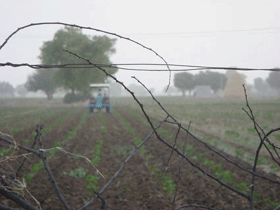
Punjab field
|
Burdened by heavy debt to banks and private moneylenders, farmers have had to take out loans to buy costly Bt cotton seeds (genetically modified seeds, injected with a pest-killing Bt toxin), pesticides, fertiliser, diesel and machinery, while making little in return. Yet they are largely oblivious to their shaping roles in a 21st century Gene Revolution, one that uses bio-technology to further increase crop yields and profits in this part of the world.
Once farmers had exchanged seeds and drawn upon inherited or local knowledge. Now farmers have to purchase corporate Bt cotton seeds and accompanying chemicals from agricultural stores, seeking advice from commission agents, shop-sellers or university experts about how best to grow their crops. GM test crops might be being ripped up in the West but in Punjab, these GM seeds are being bought and sold as the future.
GM crops do not grow without chemicals and, out in the fields, farmers spray pesticides with bare hands. They suffer rashes and allergies and during frequent spraying sessions, as the chemicals mix with the intense heat, the farmers become dizzy, collapsing in the fields. Disputed by the companies themselves, recent studies have shown that the high levels of pesticides have had serious health repercussions in Punjab, so much so that the ‘cotton belt’ is now known as the ‘cancer belt’.
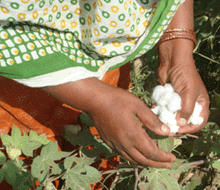
woman picking cotton
|
In a Punjab University study, high levels of pesticides have been linked to DNA mutation (increasing susceptibility to cancer). In the village of Jajjal, which has an alarmingly high rate of cancer, they tell me the water is poisoned: "When the cattle drink it, it affects the milk, too" and talk about "perdution" (pollution) in the air, water and the land.
The village elder said, “The earth is our mother because she used to raise us but now, she only works for money. Our mother is dying with the sprays and fertilisers and so, her children are dying too.”
Slowly, even the farmers are realising that the years of intensive farming introduced during the Green Revolution and the chemical farming continuing with the Gene Revolution are taking a serious toll on Punjab’s health and ecology. Serious environmental problems throughout the state include water shortages, soil erosion, deforestation and pollution. Environmentalist Vandana Shiva has written extensively about these and related issues and established the Navdanya (‘Nine Seeds’) movement to promote biodiversity and sustainable farming.
Satinder Kaur Chohan
Glossary
Chula – Clay stove fired by wood, coal or cow dung cakes
Charpoy (or manja) – A traditional Indian bed woven with rope
Desi – Native or traditional to Punjab
Chai – Indian tea
Amrika – Village ideal of America
Neem tree – A tree native to India and Punjab, especially Bathinda, with numerous medicinal properties
Bhukki – Poppy husk; an opiate
Photo credits
photographs from the Punjab by Satinder Chohan
production photographs of Zameen by Robert Day
Read Sunayana Pana's review of Zameen for confluence.org.uk.
published in 2009
After reading about farmer suicides and the impending environmental crisis in Punjab, I began trying to express these global issues through the microcosm of a small, dysfunctional family. My core characters slowly emerged - Baba, the ageing and hard-working cotton farmer, struggling against the vagaries of nature and the modern world, Chandni, the dutiful daughter, who dreams of escaping her prescribed womanly fate, and Dhani, the alcoholic and drug-addicted son, who dreams of escape to ‘Amrika’. I arrived in Barnala, Punjab, at the beginning of the cotton-sowing season. I travelled across the cotton belt, visiting villages in the southern districts of Sangrur, Moga and Bathinda. Stepping into these villages is akin to taking a step back in time – to the Punjab I visited as a child – or perhaps even the Punjab my parents fondly remember. Ostensibly, this is the old Punjab of close-knit families and village communities, wholesome food from the fields cooked over a chula stove, sleeping out on a charpoy under the stars, drinking endless cups of chai, gossip, laughter... The struggles of the land are etched on the timeworn faces of the farmers, who work unceasingly from sunrise to sunset. Maghar Singh, whose son committed suicide at the age of 35, told me, “We used to sow a lot of things – cotton, vegetables, lentils, chickpeas. Now, there are only two things left – cotton and rice... We grew our own crops, made our own milk, butter and sugar, we saved seeds, used medicines like turmeric and mustard oil, spun our own cotton, made our own clothes... Now, people are embarrassed to wear homemade cotton and go out and buy their clothes. Machines took over in the houses and the fields". It has taken almost four decades since my father left Punjab for migration to reach the remote southern parts of Punjab but now, the villagers talk excitedly about the one or two men lucky enough to pursue riches elsewhere. As India embraces Western-style consumerism, even village dowries must include expensive, modern household products, leading some villagers to think it easier to do away with a daughter’s later financial burden prior to birth. Rural Punjabi certainly retains a colour and vibrancy that a colloquial ‘British-Punjabi’ is rapidly losing. Zameen is conceived in Punjabi but it is written like a play in English translation. Treating it as such, the actors would later perform the play in their own British accents. From afar, the cotton looked like a light dusting of snow. Close up, a jungle of spiky cotton sticks scratched as we plucked cotton balls from the pods. Many stalks were covered in mealy bug – the latest pest of many to ravage Bt cotton in the fields.
I could not pick as quickly as the others, nor lasted as long, often sneaking away to stretch out under the kikar tree or lie on a charpoy when the heat or work became too much. The women had no such choice – they worked from morning to sundown, cotton sacks swelling on their backs, laughing and gossiping to get through the sweltering day. I returned to the UK determined that in spite of the way that Western playwrights like Lorca or Ibsen have influenced me, Zameen should exude the spirit of a specific form of Punjabi theatre. It draws upon the entwined folkloristic elements and consciousness-raising politics of Punjabi street theatre, often deployed in villages and cities as an instrument of social change. Zameen is a play about small lives and global issues, as relevant to audiences in India as it is to Western audiences, whose cotton is grown in developing countries where economic policies and agricultural futures are heavily influenced by the West and our G8 governments. It’s a play that requires an audience to think about and forge those global connections. As ‘First World’ global consumers, perhaps we should know a little more about the lives of ‘Third World’ rural producers – and the high cost of human suffering and environmental degradation they pay, to put the cotton clothes on our slightly more affluent backs. The village elder said, “The earth is our mother because she used to raise us but now, she only works for money. Our mother is dying with the sprays and fertilisers and so, her children are dying too.”
|
|